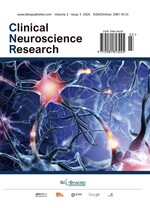Ameliorative Effect of Hedysarum polybotrys Polysaccharide on Neural Tissue Fibrosis in Diabetic Peripheral Neuropathy Mice and its Mechanisms
Abstract
Objective: This study aimed to investigate the role of Hedysarum polybotrys polysaccharide (HPS) in ameliorating neural tissue fibrosis in diabetic peripheral neuropathy (DPN) mice. Methods: Fifty DPN mice were selected and randomly divided into five groups (n = 10), which were the model group, positive control group (receiving only 4 mg/(kg-d) of α-lipoic acid), high-dose HPS group (200 mg/(kg-d) of HPS was given per day), medium-dose HPS group (100 mg/(kg-d) of HPS was given per day), and low-dose HPS group (50 mg/(kg-d) of HPS given daily). In addition, non-diabetic C57BL/6 wild-type mice were selected as the normal group (n = 10). The expression levels of Keap1 and Nrf2 proteins and their mRNAs in the sciatic nerve tissues of mice in each group were analyzed by Western blot technique and real-time fluorescence quantitative PCR. Results: Compared with the normal group, the expression of Keap1 protein and mRNA was increased, while the expression of Nrf2 protein and mRNA was decreased in the sciatic nerve of mice in the model group (P < 0.05). Compared with the model group, Keap1 protein and mRNA expression decreased, while Nrf2 protein and mRNA expression increased in the control and high and medium dose HPS groups of mice (P < 0.05). Conclusion: HPS may inhibit fibrosis of neural tissue and ameliorate nerve injury in DPN mice by regulating the Keap1/Nrf2 signaling pathway. This effect was associated with enhanced antioxidant capacity, promotion of Nrf2 activation, and increased antioxidant gene expression by HPS. Therefore, HPS has a potential therapeutic value to ameliorate DPN-associated nerve injury.
References
Charnogursky G, Lee H, Lopez N, 2013, Diabetic Neuropathy. Handbook of Clinical Neurology, 120(3): 773–785.
Matsumoto T, Ohashi Y, Yamada N, et al., 1994, Hyperglycemia as a Major Determinant of Distal Polyneuropathy Independent of Age and Diabetes Duration in Patients with Recently Diagnosed Diabetes. Diabetes Research and Clinical Practice, 26(2): 109–113.
He L, Jin ZS, Zhang L, et al., 2019, Effect of Hedysarum polybotrys Polysaccharide on High Mobility Group Protein 1-Toll-like Receptor 4 Signaling Pathway in Diabetic Peripheral Neuropathy ob/NOD Mice. Chinese Journal of Clinical Pharmacology, 35(07): 657–660.
Negi G, Kumar A, Joshi RP, et al., 2011, Oxidative Stress and Nrf2 in the Pathophysiology of Diabetic Neuropathy: Old Perspective with a New Angle. Biochemical and Biophysical Research Communications, 408(1): 1–5.
Ke CB, Huang XX, Xu XC, et al., 2010, Interaction of P38MAPK and PI3K/Akt Signaling Pathways in Diabetic Neuropathic Pain in Rats. Journal of Clinical Anaesthesiology, 26(09): 790–793.
Jin GL, Chen ZH, Luo Z, et al., 2020, Comparative Pharmacological and Pharmacodynamic Studies of Astragalus. Tibet Science and Technology, 2020(03): 51–55.
Coleman DL, 1982, Diabetes-obesity Syndromes in Mice. Diabetes, 31(Suppl. 1 Pt 2): S1–S6.
Houseknecht KL, Portocarrero CP, 1998, Leptin and its Receptors: Regulators of Whole-body Energy Homeostasis. Domestic Animal Endocrinol, 15(6): 457–475.
Zhou J, Du X, Long M, et al., 2016, Neuroprotective Effect of Berberine is Mediated by MAPK Signaling Pathway in Experimental Diabetic Neuropathy in Rats. European Journal of Pharmacology, 774(1): 87–94.
Bierhaus A, Haslbeck KM, 2004, Loss of Pain Perception in Diabetes is Dependent on a Receptor of the Immunoglobulin Superfamily. The Journal of Clinical Investigation, 114(12): 1741–1751.

